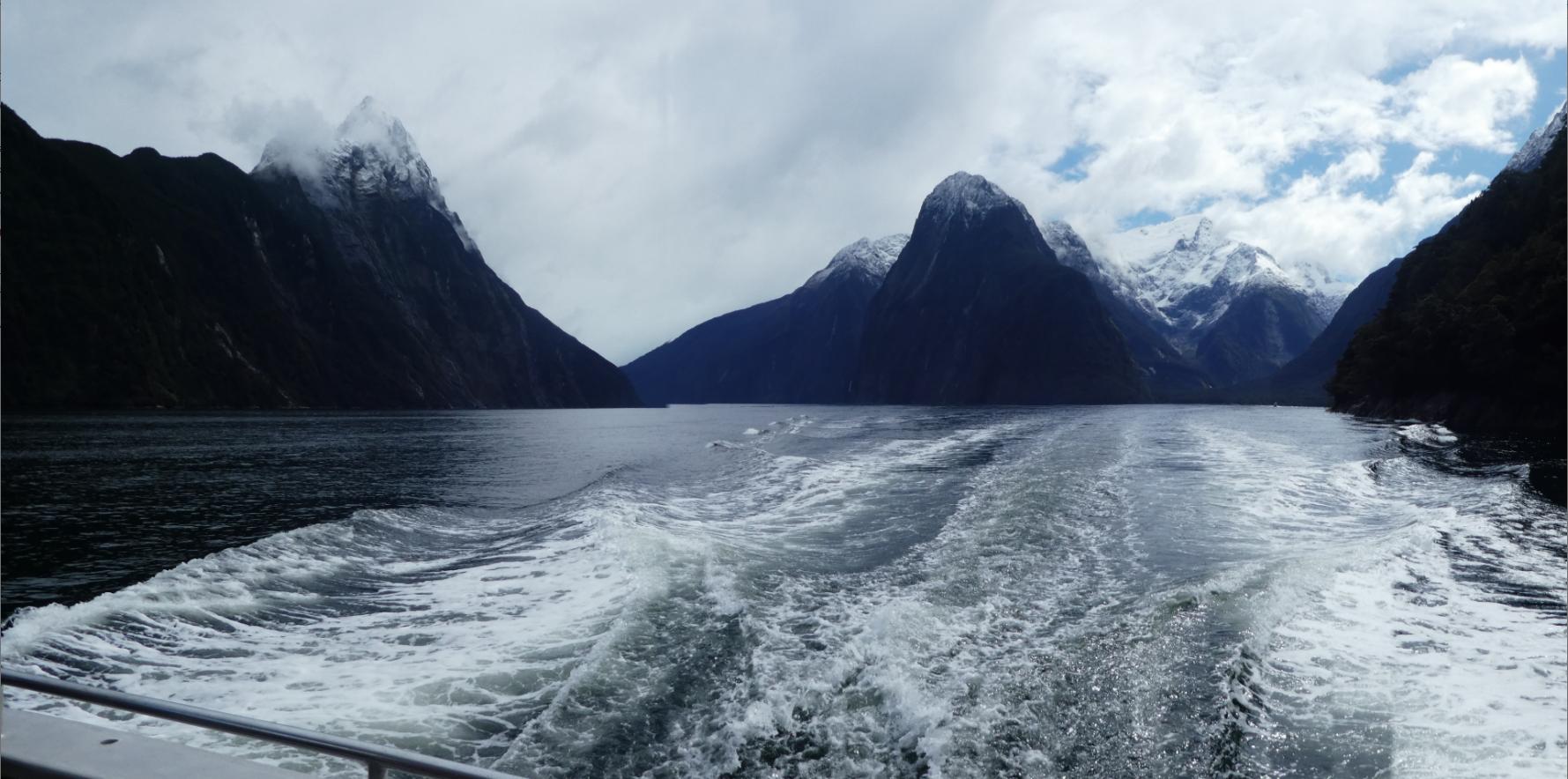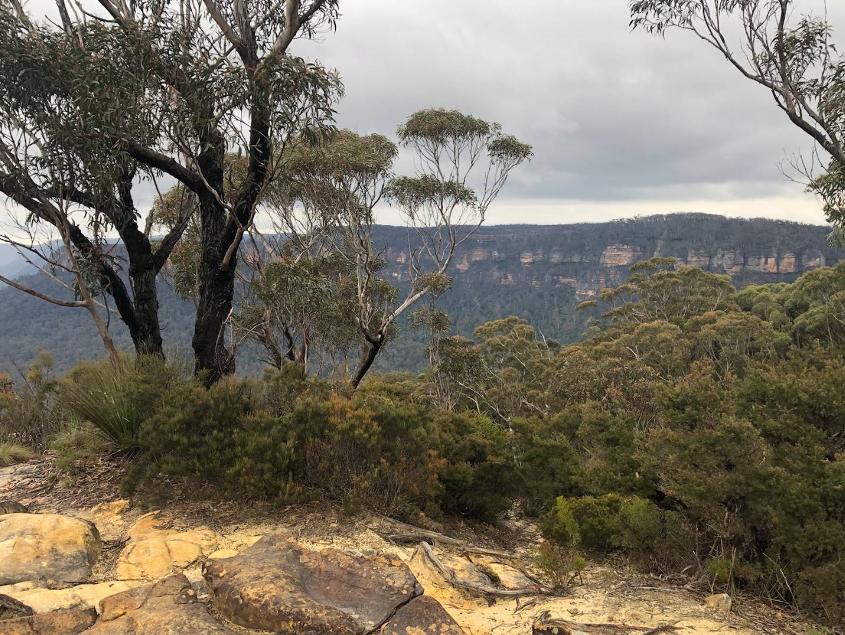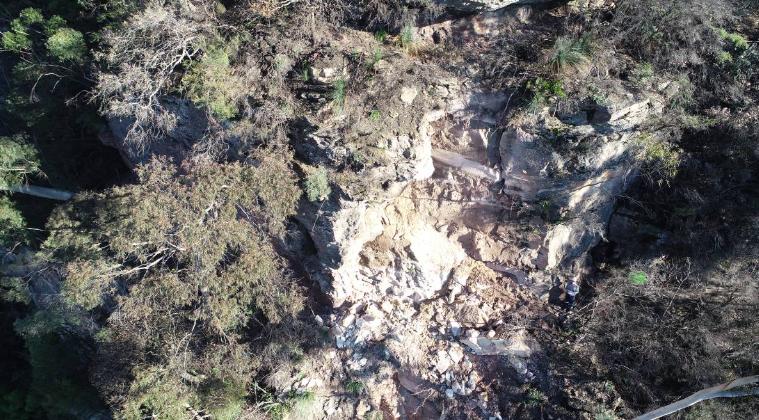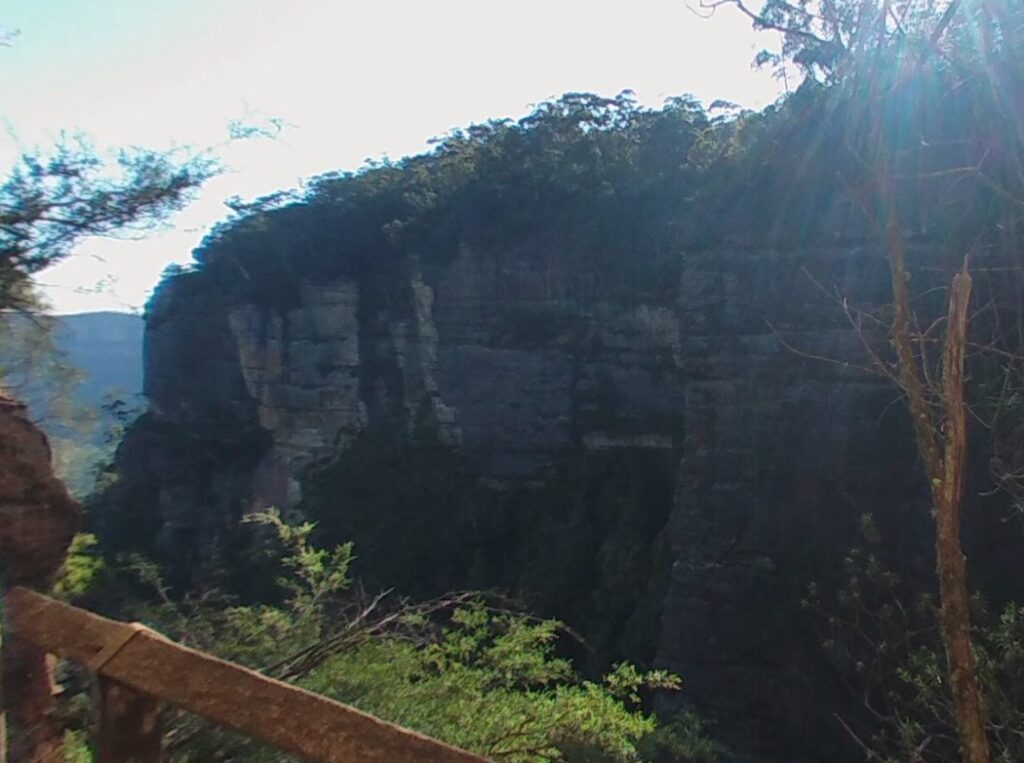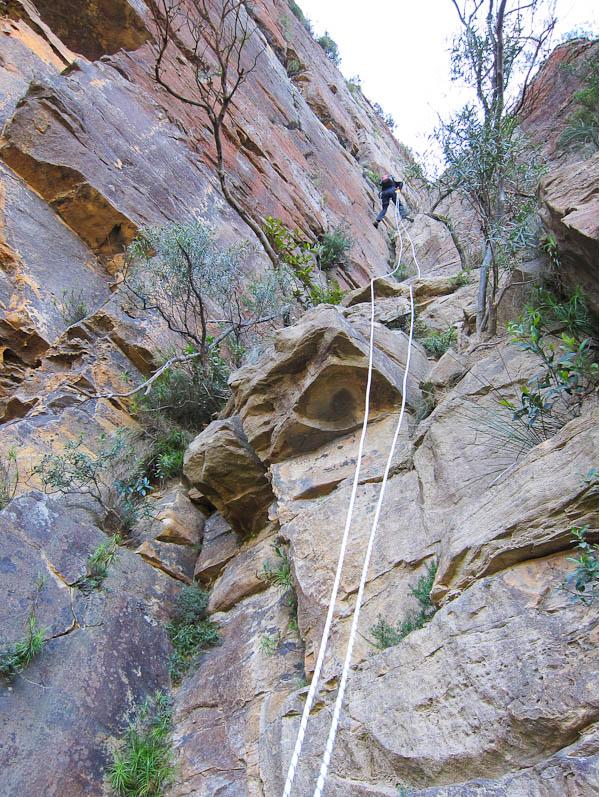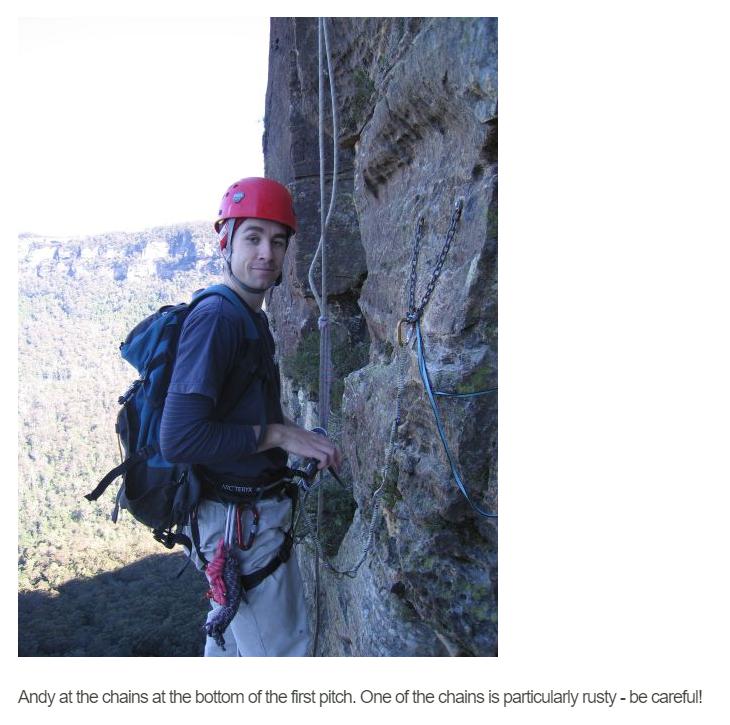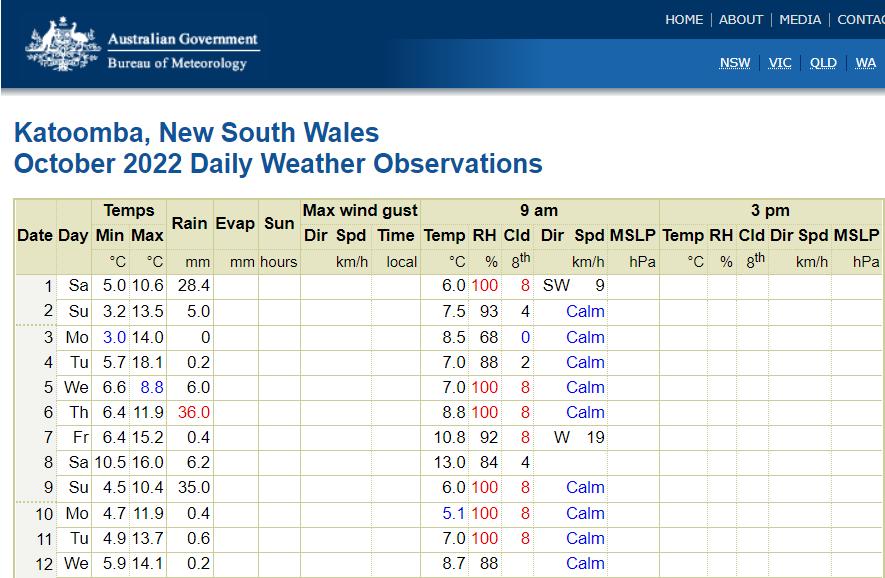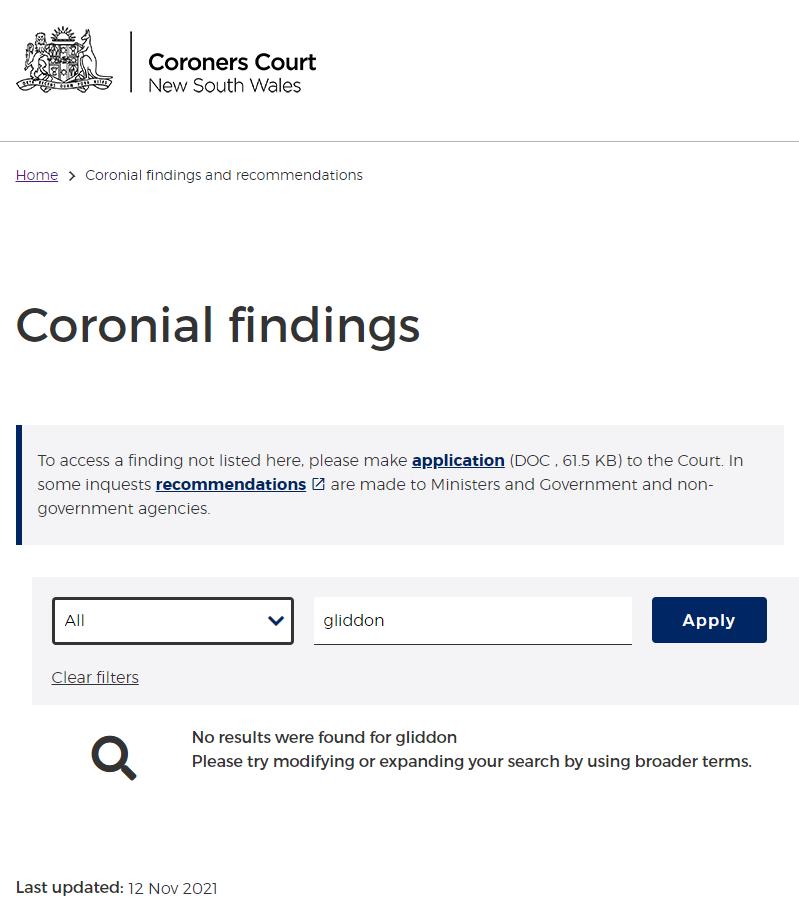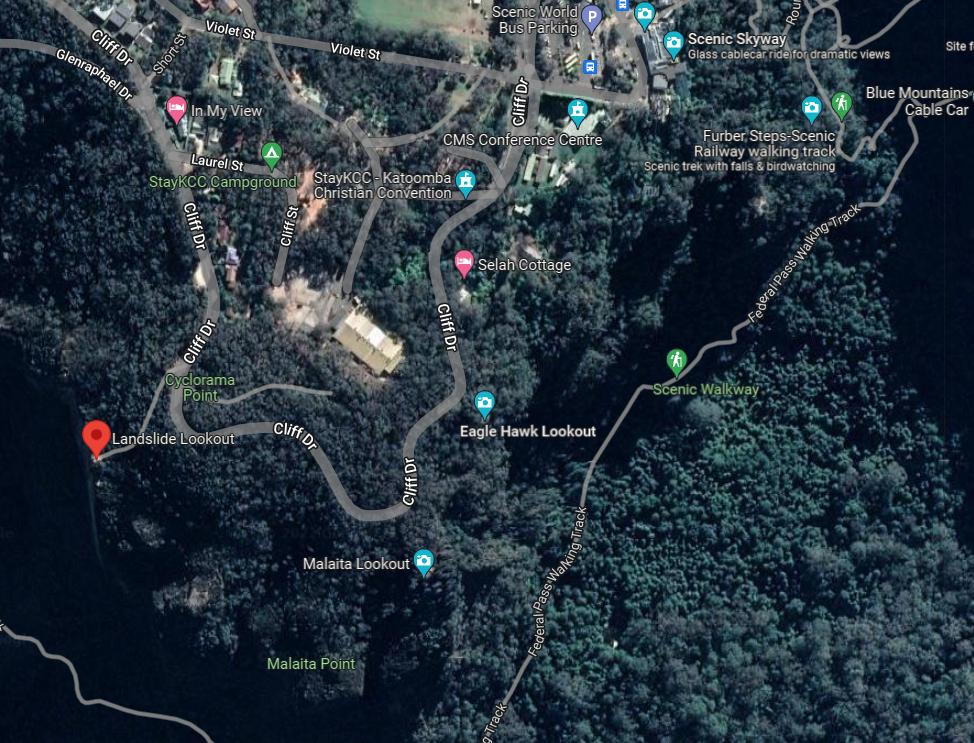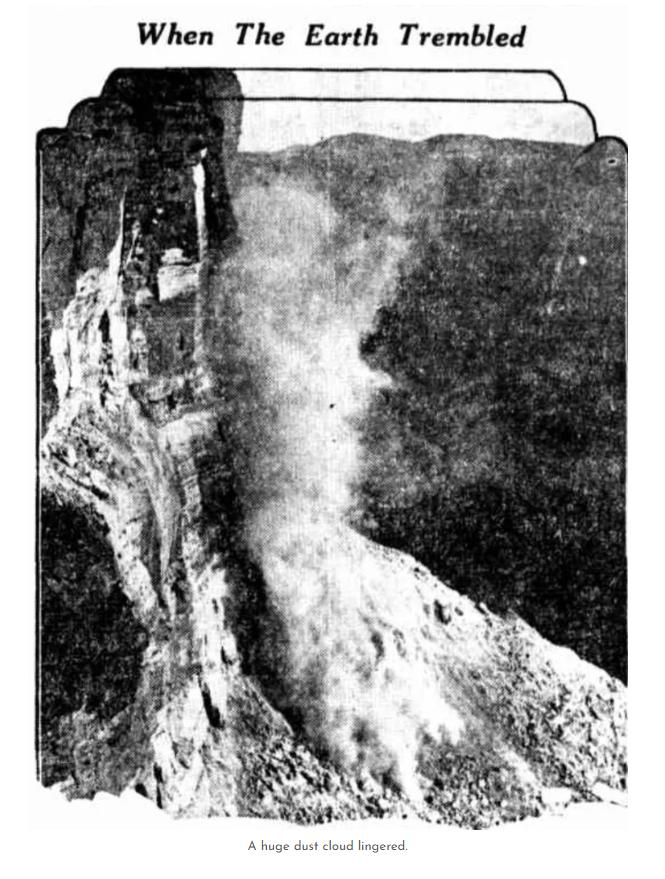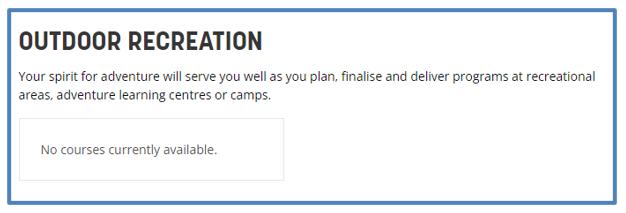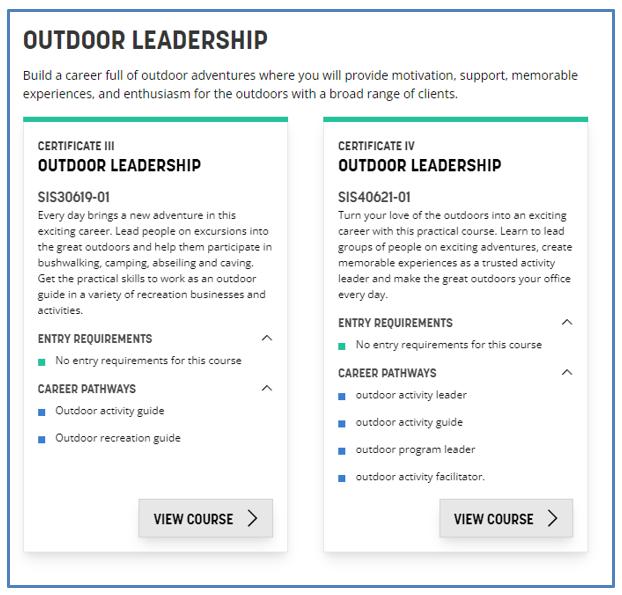Malaita Wall abseiling death of Outdoor Rec student Oliver Carrick (20) on October 7 at the hands of TAFE
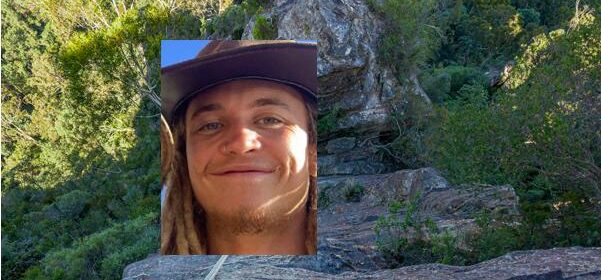
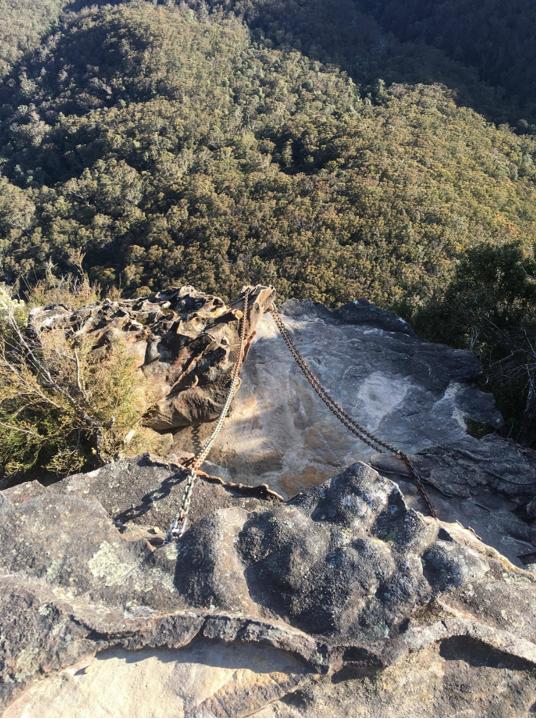
Bolts and rusty chains into the cliff face is not ‘Leave No Trace’. Oli went down but didn’t return.
“Detectives attached to Blue Mountains Police have initiated an investigation into the circumstances surrounding the man’s death. SafeWork NSW has been notified.”
Malaita Wall ?
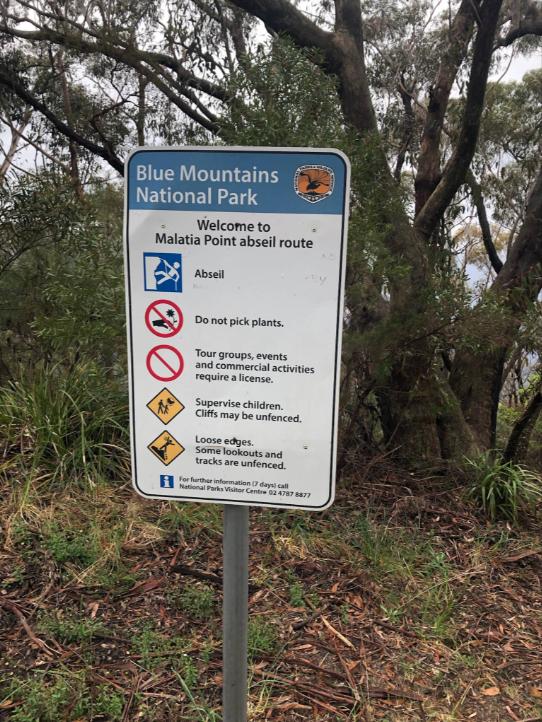
NPWS NSW is responsible for the use of Malaita Wall for abseiling and rock-climbing. This is its welcome sign on the abseiling approach.
- Echo Point Lookout: look due west across the Jamison Valley toward Malaita Point, which is at the southern (left) end of the Malaita Point headland. See the red outline below.
- Orphan Rock Lookout: a closer look westward across the Kedumba River gorge below to Malaita Wall.
- Scenic Railway bottom station: closest vista – look upward to the cliff faces of Malaita Wall westward.
Malaita Wall:
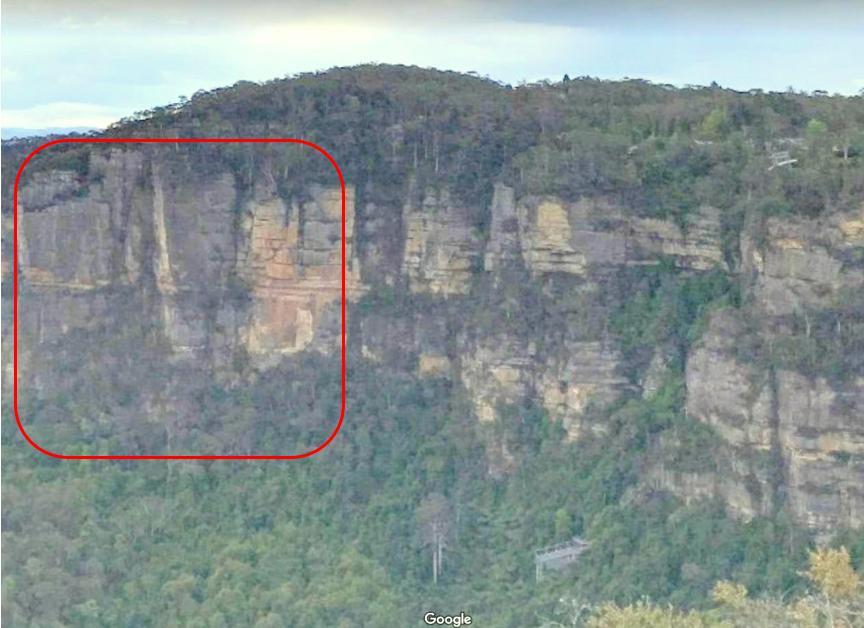
The cliff-face of Malaita Wall (inside red framed outline). This is taken looking due west across the Jamison Valley from Echo Point.
There are two features of note in the above photo, firstly the relative position of Scenic Railway bottom station below-right of the red outline.
Secondly, note the differing colours of the cliff face from grey to yellow sand. The grey coloured sections comprise hard Burra-Moko Head Sandstone composed of fine quartz. Whereas the lighter sandy coloured cliff face sections tend to be more course and crumbly. Also, a sandy coloured section can reveals evidence of recent rock fall activity, and suggests that the rock face behind has become unstable. For instance, nearby on Tuesday 28th July 2020, a section of the Golden Stairs cliff face collapsed after a bout of heavy rain, revealing the sandy coloured bedrock behind.
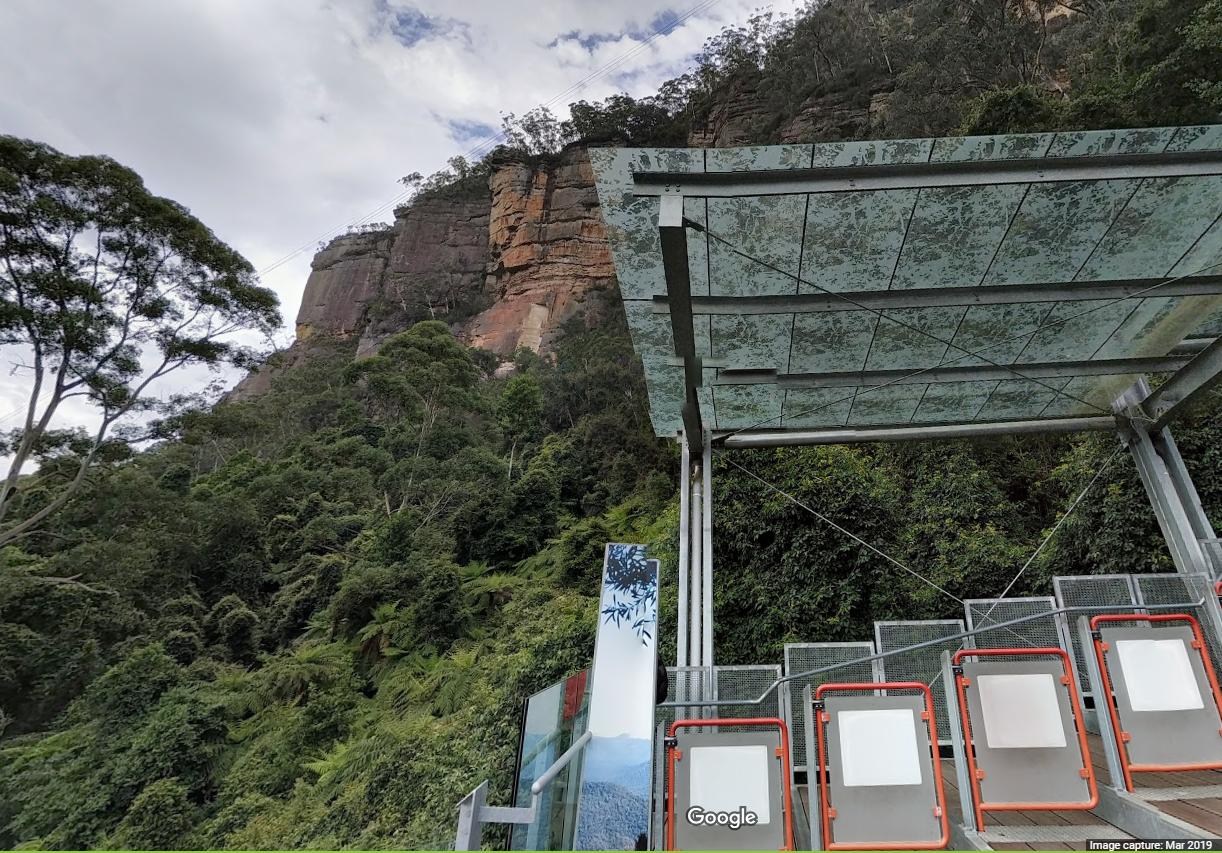
The closest photo vista of Malaita Wall taken from the Scenic Railway bottom station platform below. Note the clear evidence of a recent landslide confirmed on the sandy coloured right section of the Malaita Wall cliff face.
According to sport rock-climbing website OzUltimate:
“Malaita Wall, next to Malaita Point, is a series of five abseils down a couple of big walls into the valley below Katoomba. It is similar to Malaita Point, although the abseils are generally bigger and more exposed.”
SOURCE: OzUltimate website , ^https://ozultimate.com/canyoning/abseiling/notes/malaita_wall.htm
Malaita Wall abseiling (just the first pitch from the cliff top):
“A five-pitch journey (4 to 5 rope lengths down) into the Jamison Valley below Katoomba inside the Blue Mountains National Park…featuring impressive views of the Three Sisters and described as sure to make your heart pound”.
“Advanced (Multi-Pitch) Abseiling..an awe-inspiring wedge of rock on the edge of Katoomba where we do our abseiling…no experience required. The first abseil drop is a breathtaking 45m followed by 28m, 35m, 12m and then another 35m abseil to finish things off.”
“We are a young couple who will be moving to the Blue Mountains this year once we find a place to call home. We are ready for the leap of faith to be in a new environment with new lines of study and work, creating new friendships and experiences with all that the Blue Mountains has to offer.”
Pertinent Questions for TAFE
- At time of Oliver’s death, was Oliver engaging in a solely abseil activity or a combination of rock-climbing and abseiling?
- Was Oliver at the time training for the TAFE introductory Certificate III or the TAFE intermediate certificate IV course in Outdoor Leadership?
- Was Oliver’s abseiling death on the date of 7th October 2022 wholly under the direct supervision of a TAFE Abseiling instructor(s) employed/contracted at Wentworth Falls campus?
- How many TAFE Abseiling instructor(s) were present on site and how many rock-climbing students? What was the student/instructor ratio on the particular abseil and was this within acceptable limits?
- What record of skills and experience (abseiling expertise) did the supervising TAFE Abseiling instructor(s) have at the time of Oliver’s tragic cliff fall?
- Was the TAFE Outdoor Recreation instructor(s)? at any time distracted to fully monitor Oliver’s abseil?
- What was(were) the name(s) of the TAFE Abseiling instructor(s) training Oliver?
- What record of skills and experience did TAFE Abseiling instructor(s) have about Oliver at the time of his tragic cliff fall?
- Was such a multi-pitch site as the 200m Malaita Wall deemed suitably appropriate by TAFE for a beginner rock-climbing student like Oliver?
- Which instructor(s) made the planning decision to select this site, route and to include Oliver in the abseil activity?
- When and which TAFE Abseiling instructor(s) supervising this abseiling activity had undertaken a reconnoitre of the particular abseil route and inspected the conditions, cliff bolts and chains?
- Which TAFE Outdoor Recreation operational records and documents confirm the planning and preparations of the abseil activity and have these been provided to senior police in charge of investigating this death?
- What other abseil cliff face sites were available to be deemed suitably appropriate by TAFE Abseiling instructor(s) for a climbing student beginner like Oliver?
- Which abseil route (name) was chose by the TAFE Abseiling instructor(s) of the many options along Malaita Wall? Why was this route chosen instead of others?
- Was the TAFE Abseiling instructor(s) on site and close to Oliver at the time of Oliver’s fall? What are their names?
- What exact qualifications and experience did the supervising TAFE Abseiling instructor(s) have?
- Which abseil route was chosen by the TAFE Abseiling instructor(s) of the many options along Malaita Wall?
- How many rope pitch belays were necessary for this particular abseiling descent?
- During which abseil pitch did Oliver fall? At the end of the first one?
- What specifically caused Oliver to fall?
- Did Oliver run out of abseil rope?
- Did Oliver slip in the wet conditions?
- Was there a belay person at the rope base of each abseil pitch to tension the rope for Oliver? Was this done properly?
- Was Oliver using an auto-belay device? These have been reported problematic give the recent fatality at Sydney Indoor Climbing Gym in St Peters on 13th October 2021. [>Read the SafeWorkNSW Incident Information Release]
- How many trained TAFE Abseiling instructor(s) were paying attention to Oliver during his abseil descent at the time of his the fall?
- Has the TAFE Abseiling instructor(s) made a full witness statement to police as to the event and their description of how Oliver fell to his death?
- Was Oliver in any way unwell or injured on the day of his cliff fall death, or recently beforehand?
- Did Oliver have any prior injuries or health problems?
- Was Oliver sufficiently approved by the TAFE Abseiling instructor(s) to be competent to tackle this multi-pitch abseil?
- Was this the first time that Oliver had tackled this particular route down Malaita Wall?
- Was Oliver checked by the TAFE Abseiling instructor(s) that he was wearing all the appropriate abseiling gear at the time of the abseil? (helmet, gloves climbing boots) [Note: According to media reports, Oliver was not wealthy enough to be able to afford all the best climbing/abseiling gear.]
- Was the abseil wholly compliant with Outdoor Council of Australia’s current Adventure Activity Good Practice Guide for Abseiling and Climbing? [>Read Guidelines]
- When was the TAFE abseiling gear used by Oliver last inspected and certified as safe?
- Did TAFE provide travel insurance to Oliver given his participation in such an inherently high-risk training pursuit as abseiling?
- Was Oliver equipped with a descent-control device?
- Was Oliver equipped with a personal anchor system?
- Was Oliver properly wearing an approved abseiling helmet?
- What was the length and condition of Oliver’s rope(s)?
- How far did Oliver fall? Various media reports vary from 40m to 65m.
- Did the TAFE Abseiling instructor(s) properly ensure that Oliver did not run out of rope length on this multi-pitch abseil?
- Did the TAFE Abseiling instructor(s) properly ensure that Oliver tie a stopper knot properly in the end of each of his ropes?
- Did the TAFE Abseiling instructor(s) properly ensure a short sling was attached to Oli’s belay loop with a girth hitch and clip your device to it?
- What were the weather conditions at Malaita Wall early in the morning of Friday 7th October 2022?
- Why did the TAFE Abseiling instructor(s) go ahead with the training beginner abseil when the local Katoomba weather had just received 36mm of rain and so saturating the cliff face?
- The Blue Mountains are west of Sydney not “in Sydney’s far west”
- The Blue Mountains area is not experiencing “significant growth in its population and demographics”. Rather local council statistics forecast an average annual population increase rate of just 0.26% between 2016 and 2036.
- The Blue Mountains is mainly regional residential with no heavy industry to speak of. The Outdoor Recreation ‘industry’ attracts a relatively small special interest adventure tourism, mostly from overseas which could take years to recover after the government lockdowns 2020-2021
- “TAFE NSW Blue Mountains – Wentworth Falls is committed to meeting the needs of both our students and industry.” Yeah, like Oliver Carrick this month? And once a student graduates, TAFE cares only for the new intake – a Harp Seal notorious for leaving her pups after 12 days.
Coronial Findings aren’t Publicised
The media invariably state: “A report will be prepared for the coroner“. But how cliché of the media and inconclusive?
So, “a report will be prepared for the coroner”. That would likely enable the coroner conclude the cause of death, and in such a case as abseiling one might well predict the likely cause.
But the coroner does not prepare a report to the public as standard practice, that is, unless there is an inquest. In New South Wales the coroner rarely reports his/her findings, let alone makes any subsequent recommendations to the public or to the relevant industry/authorities. This is even when a decision is made to conduct an inquest – such as when the death is not by natural causes, or in the case is a suspected homicide or if the identity of the person who died is not known.
It seems that such reports are always kept secret by the NSW Coroner and so the so-called ‘industry’ and public don’t get to find out what really happened, such as the contributing factors that led to the death. So the perpetuating problem is that those involved in outdoor recreation pursuits (the participants, commercial operators, training organisations, and representative bodies) don’t get an opportunity to learn from the mistakes of others.
Under current authority, the only hope for the contributory causes of this fatality to be revealed publicly is for SafeWork NSW to apply its investigation results as an Incident Information Release publicised on its website and distributed to the lead industry body to disseminate to its member organisations.
So the mistakes perpetuate, and further tragic deaths – each dismissed as “a tragic accident“, “a one-off event“, “a mishap“, “a miscalculation“, “an accepted risk of rockclimbing“, “goes with the territory”, “a misadventure” and “due to unforeseen circumstances“, and even “par for the course“…but never poor quality assurance protocols, a failure in governance (systemic or an oversight), or due to contributory negligence or culpability.
Blue Mountains Tragedies All Too Frequent
Malaita is Landslide Prone
Recall our first photo above showing lighter coloured cliff face of the northern-most section of Malaita Wall? It is evidence of recent rock fall activity.
The entire headland has a history of kerosene shale mining on and off from the 1970s to the 1930s with varying successes and failures. A network of mining tunnels was constructed into the sandstone headland and dynamite was deployed.
Just around the corner of Malaita Point (of what is basically Malaita headland unnamed) is a lookout called Landslide Lookout (location shown below).
Landslide Lookout looks over a massive cliff landslide on the western side of this headland.
This is the vista from atop Narrow Neck peninsula.
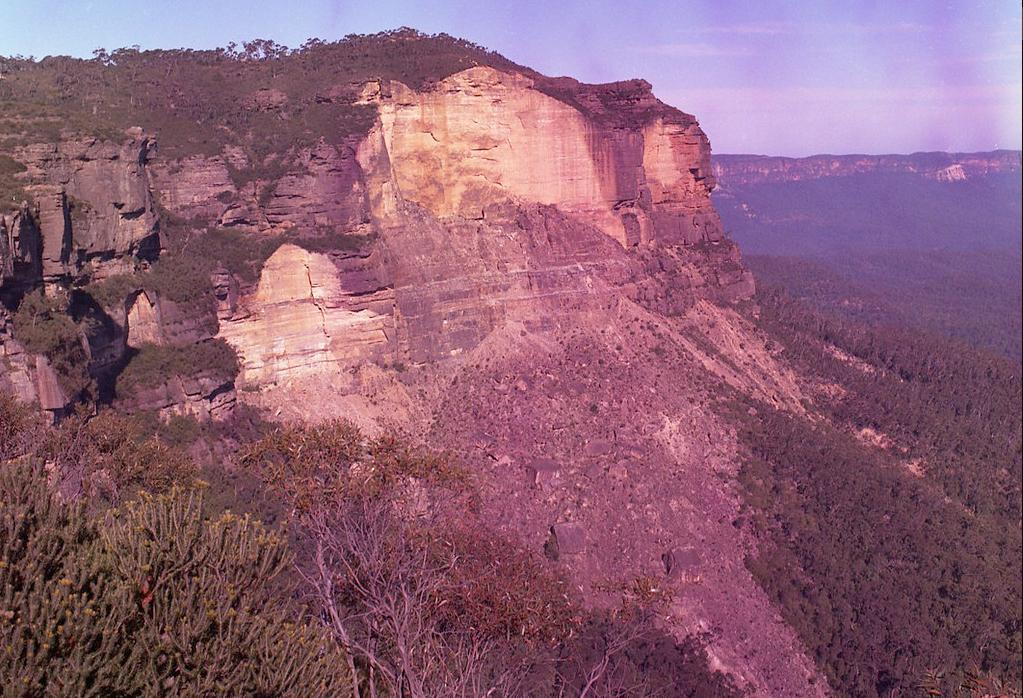
The notorious landslide west of Malaita Point from 1925 as a direct consequence of shale mining and the use of dynamite underground In 1925, the Katoomba Colliery re-opening the coal mine at the base of the cliffs to supply coal shale to the the Carrington Hotel’s Katoomba Electric Power-house.
Small landslides had occurred from 27th January 1931, caused by weakened mine tunnels underneath the cliff when the mine was abandoned and the props removed. On 2nd May 1931, when Dog Face cliff ultimately collapsed into the Jamison Valley a cloud of dust.
NSW Outdoor Industry is not learning
“It is indeed a tragedy and we extend our heartfelt condolences, thoughts and prayers to the family, friends and colleagues. Out of respect to the family we won’t be commenting on the incident until the investigations are complete. We are focusing our full efforts on support for the industry and those colleagues directly affected as the whole industry is grieving from this event.”
“We won’t be commenting on the incident until the investigations are complete.”…?
DISCLAIMER:
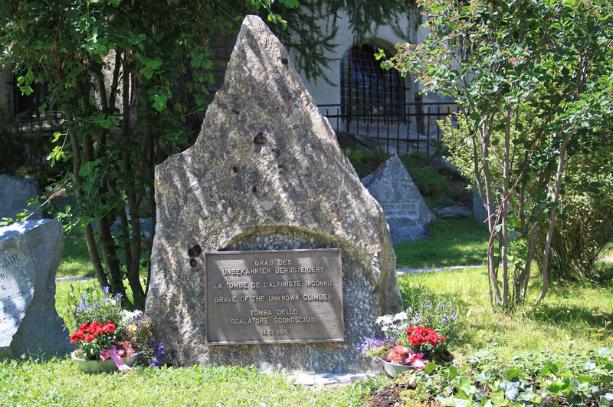
Grave of the Unknown Climber (below The Matterhorn)
Postscript:
[3rd January 2023]
Shortly after this tragic abseiling fatality at Katoomba, one reads in the local newspaper that the Blue Mountains TAFE Outdoor Leadership course based at nearby Wentworth Falls has been suspended until a review be completed.
A review into this training fatality has merit, however, it is publicly unclear what that review would entail and to be reviewed by whom? Is it an internal TAFE review of the incident, of the course curriculum, of the operational safety protocols, or of the training and student evaluation standards?
An independent expert investigation would garner more merit, especially to the family.
An independent expert investigation with recommendations to avoid a repeat has even more merit, plus the full and immediate implementation of those recommendations by TAFE. Such is typically what a grieving family would wish for as the only positive for such a tragic loss of a loved one.
But this is best practice, is it not? Are we learning? Is this outdoor recreation craft, a complex field of many umbrella skill-sets, (Group Field Leadership being just one) and sso getting more competent and professional?
Or is the course being dumbed down due to NSW Government budget cuts?
Is the TAFE Course Up to Scratch?
When Nature Trail’s Tour Director, Steve, was a former student at TAFE [2013-2016], the course used to be termed ‘Outdoor Recreation‘ and for years it had been offered in a graduated stream as Certificate III, then Certificate IV and then to Diploma level. Steve’s qualifications are listed on this website under Our Credentials.
Each of the three course levels was offered on a part-time basis for a single semester period of 6 months. The curriculum was a mix of core practical study units as well as various elective options for specialist skill focuses such as bushwalking, abseiling, rock climbing, canoeing to instructor level.
At the time, there were three campus options in New South Wales – Wentworth Falls, Lithgow and Kurri Kurri (situated in the Hunter Valley about 36km WNW of Newcastle).
In addition, ‘Guiding’ as an allied skill set was offered part-time over a 12 month period at the Ultimo campus in Sydney. It was previously included as part of the Wentworth Falls campus as part of a broader skill based, more comprehensive outdoor recreation offering.
However, following a series of NSW Government budget cuts to TAFE since the NSW Liberal-Nationals coalition have been in government, the course syllabus, staffing and student number limit have been steadily reduced.
Since around 2017, the courses have had a name change from ‘Outdoor Recreation‘ to ‘Outdoor Leadership‘, refocusing away from technical skilling to a more skeleton outdoor leadership focus.
SOURCE: TAFE NSW, 2023-01-03, ^https://www.tafensw.edu.au/course-areas/sport-and-recreation#outdoor-recreation
Surely leadership is a capstone skill-set to be acquired once the activity skills-sets have been acquired to a high standard. One can’t supervise others if one is not fully competent in the activity skills.
These are TAFE NSW only available outdoor recreation focused courses in 2023. Note that there are “No entry requirements” for either the Cert III or Cert IV, yet the emphasis is on leadership, less so the nuts and bolts doing.
The beginner level Certificate III course and the intermediate level Certificate IV course are currently the only offered courses in ‘Outdoor Leadership’ by NSW TAFE for 2023. These are being offered at Wentworth Falls and Kurri Kurri campuses, but not at Lithgow campus.
The courses are “non-roping”, that is no abseiling, no rock climbing, no canyoning, no caving. Instead, bicycling has been added as a optional speciality skill-set. Perhaps this is the outcome of the ‘review’ after the fatality – so TAFE has lost its accreditation in this respect? That would mean NSW-wide. This is not helpful to adventure tourism in Australia.
Rather than being offered part time for a period of 6 months when Nature Trail’s Tour Director was a former student, they are only for 4 months, so a much reduced curriculum, and pretty much the same as in Semester 2 of 2022 when Oliver Carrick was a student at Wentworth Falls.
Safework NSW Investigation into the Fatality
Being an organisational employer and educational institution in the state of New South Wales, the New South Wales Government’s Safework NSW conducted a mandatory investigation into outdoor leadership student Oliver Carrick’s cliff-face death while under TAFE training supervision.
This is Safework NSW’s undated report (circa December 2022):
 Loading...
Loading...
Any the wiser for this one page report by Safework NSW?
All this Incident Information Release provides as a cause is the statement:
“The student attached the abseil equipment and commenced to weight his rope. As he leaned backwards, it appears the rope released/loosened, and he fell 50 metres.”
So he just failed to tie a proper knot in his rope?
Reports of how far he fell down the cliff-face vary from 40m, 45m, 50m and 65m. Whilst the fatal outcome would not likely vary, did anyone official measure the drop?
Without being a qualified abseiler, but having abseiled in the past at university, there are a number of particular knots that secure an abseiler to an anchor point of the top of a cliff-face, before leaning back on the cliff edge and relying on the rope(s) to take one’s weight. This is Abseiling 101, so what was Oliver doing atop the cliff pre-abseil? Was he physically and mentally fit at the time? Presumably there was no autopsy by a forensic pathologist to verify the extent of any contributory negligence by Oliver.
Was a TAFE training instructor supervising him at this critical juncture to ensure all his roping was correct and safe, ready to abseil? It would seem not.
Aside from the Safework NSW report’s one sentence conclusion, the report’s following ‘Safety Information’ section seems to be just a regurgitation of summary protocols from the particular training course, that is, what should have be done, just each brief high-level motherhood statements.
Safework NSW is charged with focusing on safety in NSW workplaces and predominantly gets involved in the accident-prone Construction industry. However, Safework NSW has little if any knowledge about the Outdoor Recreation industry and has no code of practice applicable. It seems that by default this is left up to operators like TAFE to self-regulate.
So, in the wash up, despite perhaps family and industry expectations:
- The Safework NSW report was amateur and scant at best, could have been quickly researched and compiled from a desk in Lidcombe
- The TAFE review into the incident has not been made public (not perhaps even conducted)
- No autopsy was conducted and no autopsy report, so who knows or sure? No-one ever will.
- There is no indication that there will be a coronial inquest, so no coronial findings are to be made public because there were no coronial findings or report. [Note: There was no coronial inquest into the deaths of David Gliddon (Nov 2017), Kelly Ann Foster and Yuanlei Qi (Jan 2021) or Richard Mills Nov (2022). But there were coronial inquests and public reports respectively into David Iredale (Dec 2006) Gary Tweddle (Jul 2013)].
- In Oliver Carrick’s case, at least the media will be content that “a report has been prepared for the coroner” – which serves what purpose exactly.
The NSW authorities, yet again are dismissing this fatality as just another “rare” ‘misadventure accident’ inherent in the nature of Outdoor Recreation activities in the Blue Mountains Region (ignoring many others in regions around the state and Australia).
Surely, Australia needs to learn from this.
“Those who cannot remember the past are condemned to repeat it.”
– George Santayana, The Life of Reason, 1905. From the series Great Ideas of Western Man.
Further Reading:
[1] ‘TAFE abseiling student dies following fall from Malaita Wall in Katoomba, Blue Mountains‘, 2022-10-07, by B C Lewis, ^https://www.bluemountainsgazette.com.au/story/7933382/tafe-abseiling-student-dies-after-cliff-fall-in-katoomba/
[3] ‘Man dies abseiling at popular Blue Mountains spot‘, 2022-10-07, by Sarah Keoghan, Sydney Morning Herald, ^https://www.smh.com.au/national/nsw/man-dies-abseiling-at-popular-blue-mountains-spot-20221007-p5bnyh.html
[6] ‘Malaita Wall abseil expedition‘, Blue Mountains Adventure Company, ^https://bmac.com.au/blue-mountains-abseiling/malaita-wall-abseil-expedition
[8] ‘Abseiling Basics & Best Practices‘, 2022-03-10, by CityROCK, ^https://goodbeta.co.za/abseiling-basics-best-practices/
[10] ‘Katoomba, New South Wales, October 2022 Daily Weather Observations’, Australian Bureau of meteorology, ^http://www.bom.gov.au/climate/dwo/IDCJDW2068.latest.shtml, Monday, 24 October 2022.
[11] ‘The Great Katoomba Rockfall‘, 2018, (website) by historian and writer, Pauline Connolly, ^https://paulineconolly.com/2018/rock-fall-in-kaoomba-1931-it-became-a-huge-tourist-attraction/
[12] ‘Australian Adventure Activity Standard and related Good Practice Guides‘, Outdoor Council of Australia, ^https://australianaas.org.au/
[13] ‘Indoor rock climbing fall‘, 2021-10-13, SafeWork NSW, ^https://www.safework.nsw.gov.au/compliance-and-prosecutions/incident-information-releases/other-industries/indoor-rock-climbing-fall
[14] ‘Indoor rock climbing fall (13 October 2021)‘, SafeWorkNSW website, ^https://www.safework.nsw.gov.au/compliance-and-prosecutions/incident-information-releases/other-industries/indoor-rock-climbing-fall
[15] ‘Grave of the Unknown Climber‘, Zermatt, Switzerland, ^https://www.zermatt.ch/en/Media/Attractions/Grave-of-the-Unknown-Climber
[16] ‘Deaths in the Mountains‘ (this Blog search category) >https://naturetrail.com.au/blog-category/deaths-in-the-mountains/
[19] ‘Bodyboarding community pays tribute to TAFE student Oli Carrick killed in abseiling tragedy‘, 20221031, Blue Mountains Gazette, 20221031, by journalist Brenda Cunningham Lewis, ^https://www.bluemountainsgazette.com.au/story/7963119/bodyboarding-community-pays-tribute-to-tafe-student-killed-in-abseiling-tragedy/
[20] ‘TAFE abseiling student in Katoomba cliff fall identified as Oliver Carrick‘, 20221017, Blue Mountains Gazette, 20221031, by journalist Brenda Cunningham Lewis, ^https://www.bluemountainsgazette.com.au/story/7940582/tafe-abseiling-student-identified-in-katoomba-cliff-fall/
[21] ‘Abseiling fatality (7 October 2022)‘, Incident Information Releases, by SafeWork NSW (NSW Government department), ^https://www.safework.nsw.gov.au/compliance-and-prosecutions/incident-information-releases/other-industries/abseiling-fatality

